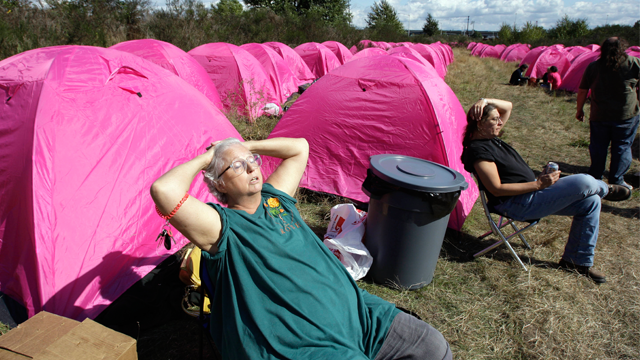This post first appeared at TalkPoverty.

Catharine Fletcher suns herself in front of one of over a hundred brilliant pink tents set up as a shelter for homeless people in September 2008, in Seattle. Fletcher is no longer homeless, but was helping out at the encampment. (AP Photo/Elaine Thompson)
This week, the city of Boston conducted its annual Homeless Census, during which teams of volunteers spanned the city and counted the number of people living on the streets, in shelters, or transitional housing. Data from the annual count is used to make decisions about where to spend scarce resources to reduce and prevent homelessness among individuals and families.
The quick and obvious answer to the question of how to address homelessness is to provide permanent housing to those who need it. A New Yorker article published last fall about Utah’s wildly successfully policy of giving housing to people who are homeless went viral on social media. Last month, Seattle officials announced plans to open three “tent cities” to provide shelter to people who are homeless. In addition, President Obama’s plan to end homelessness among veterans has had success, in part, because of its focus on immediately placing people who are homeless into permanent housing without requiring them to first complete an alcohol or drug treatment program.
There is no question that one of the keys to reducing homelessness among individuals and families is to provide them with housing. But much like health reform advocates known as “upstreamists” want to see health insurers pay for prevention initiatives that will keep people healthy, those working to end homelessness know that the ultimate solution must include reforms that will prevent people from becoming homeless in the first place.
For example, a veteran who is able to find employment is much less likely to experience homelessness than one who can’t land a job in the first place. A single parent with two school age children needs to earn at least $29.30 an hour (in Massachusetts) in order to dramatically lessen the likelihood of experiencing homelessness or housing instability that that same parent would face earning minimum wage. And a person trying to find housing after a period of incarceration is unlikely to succeed unless he or she is also able to find employment, a task that may prove difficult due to the common practice of potential employers discriminating against applicants who have criminal records.
In order to achieve longer-term success in reducing homelessness, we should focus on three areas:
Community support for those trying to live independently after a period of incarceration.
People with criminal records face barriers to employment due to discrimination. It’s hard to think of anyone better situated to make the successful transition from prison than Piper Kerman, author of the memoir Orange Is the New Black upon which the successful Netflix series is based. When Kerman sought to rebuild her life after her release from prison, she enjoyed the support of family and friends, and had the advantage of past career accomplishments. Yet in multiple interviews, she cites one factor as being the most important in her post-incarceration success: the job that a friend had waiting for her, and which she was able to begin just one week after leaving prison. Very few of those emerging from prison have a job waiting for them. As they seek employment, many will need intensive skills training, as well as support connecting them with health care providers and, if needed, substance abuse programs. Further, we need reforms that address the many barriers formerly incarcerated people face, with regard to employment, housing, public assistance, education and training, building good credit, and more.
Job skills training for the long-term unemployed.
It takes marketable skills in local, growing industries to land a job that will lift someone out of homelessness ― and keep them housed. Such training must run the gamut from classroom-based instruction in computer and customer service skills to actual employment via internships or social enterprises focused on providing real world work experience. Robust training programs will also support job seekers throughout the employment application and interview process, offer meaningful references and networking opportunities, and provide ongoing support during the inevitable ups and downs of employment.
Support for those who are disproportionately likely to experience homelessness.
Veterans, single mothers living in poverty, and individuals dealing with substance abuse, particularly those who are also living in poverty, are all disproportionately likely to become homeless, while at the same time facing multiple barriers to employment. To reduce their risk, we need more targeted outreach with services tailored to meet the needs of these groups, which can help them stabilize their lives so that they never become homeless in the first place. These services include assistance accessing health care, including mental health care and substance use recovery programs; legal assistance with collecting financial support from estranged or divorced partners; and affordable daycare.
While it is critical that we provide housing to reduce homelessness among individuals and families, the ultimate solution to ending homelessness must involve preventing it from occurring in the first place. That means reliable employment that pays decent wages — it means talking jobs as well as homes.
The views expressed in this post are the author’s alone, and presented here to offer a variety of perspectives to our readers.


